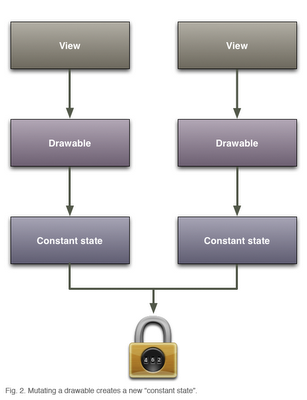Android's drawables are extremely useful to easily build applications. A
Drawable is a pluggable drawing
container that is usually associated with a View. For instance, a
BitmapDrawable is used to display
images, a ShapeDrawable to draw
shapes and gradients, and so on. You can even combine them to create complex
renderings.
Drawables allow you to easily customize the rendering of the widgets without
subclassing them. As a matter of fact, they are so convenient that most of the
default Android apps and widgets are built using drawables; there are about 700
drawables used in the core Android framework. Because drawables are used so
extensively throughout the system, Android optimizes them when they are loaded
from resources. For instance, every time you create a
Button, a new drawable is loaded from the framework
resources (android.R.drawable.btn_default). This means all buttons
across all the apps use a different drawable instance as their background.
However, all these drawables share a common state, called the "constant state."
The content of this state varies according to the type of drawable you are
using, but it usually contains all the properties that can be defined by a
resource. In the case of a button, the constant state contains a bitmap image.
This way, all buttons across all applications share the same bitmap, which saves
a lot of memory.
The following diagram shows what entities are created when you assign the same image resource as the background of two different views. As you can see, two drawables are created but they both share the same constant state, hence the same bitmap:

This state sharing feature is great to avoid wasting memory but it can cause
problems when you try to modify the properties of a drawable. Imagine an
application with a list of books. Each book has a star next to its name, totally
opaque when the user marks the book as a favorite, and translucent when the book
is not a favorite. To achieve this effect, you would probably write the
following code in your list adapter's getView() method:
Book book = ...;
TextView listItem = ...;
listItem.setText(book.getTitle());
Drawable star = context.getResources().getDrawable(R.drawable.star);
if (book.isFavorite()) {
star.setAlpha(255); // opaque
} else {
star.setAlpha(70); // translucent
}
Unfortunately, this piece of code yields a rather strange result: all of the drawables have the same opacity:

This result is explained by the constant state. Even though we are getting a new drawable instance for each list item, the constant state remains the same and, in the case of BitmapDrawable, the opacity is part of the constant state. Thus, changing the opacity of one drawable instance changes the opacity of all the other instances. Even worse, working around this issue was not easy with Android 1.0 and 1.1.
Android 1.5 and higher offers a very easy way to solve this issue
with the new mutate() method.
When you invoke this method on a drawable, the constant state of the
drawable is duplicated to allow you to change any property without
affecting other drawables. Note that bitmaps are still shared, even
after mutating a drawable. The diagram below shows what happens when
you invoke mutate() on a drawable:

Let's update our previous piece of code to make use of mutate():
Drawable star = context.getResources().getDrawable(R.drawable.star);
if (book.isFavorite()) {
star.mutate().setAlpha(255); // opaque
} else {
star. mutate().setAlpha(70); // translucent
}
For convenience, mutate()
returns the drawable itself, which allows to chain method calls. It
does not however create a new drawable instance. With this new piece of
code, our application now behaves correctly:
